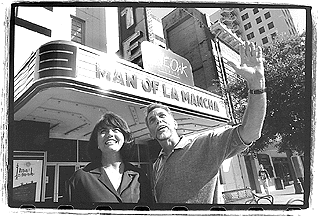The Impossible Dream
Should Public Money Go to Private Theatre?
By Kayte VanScoy, Fri., Sept. 19, 1997
|
|
Normally, council meetings are about as compelling as algebra class, but last week the chamber was abuzz with Austin celebrity. The unlikely draw? A mundane bond issue with a serpentine, 12-year history. Councilmember Beverly Griffith huddled with Assistant City Manager Toby Futrell, Parks board member MaryK Isaacs, and Arts Commission president Maxine Barkan. Susan Walker, president of the board of Live Oak Theatre and the wife of singer Jerry Jeff Walker, chatted up Mayor Kirk Watson. One of Austin's premier architects, Sinclair Black, stood talking to Councilmember Daryl Slusher. All the buzz and whispers were centered on one thing: $2 million slated way back in 1985 for the renovation of the dilapidated State Theatre at 719 Congress Avenue.
Ah, the halcyon days of 1985. New buildings were popping up all over town, Congress Avenue was being revamped for the Texas sesquicentennial, and Austin's cup was running over with real estate cash. And into this idyllic landscape floated a $20 million bond election for arts facilities. Why not, right? Austin was booming out of its seams. Unfortunately, the city was also headed for the bust of the century.
Successful at the polls, the bond proposal set aside funds for the Austin Museum of Art and Zachary Scott Theatre, and included $2 million for the rehabilitation of the State Theatre by its next-door neighbor, the Paramount Theatre. This much is a matter of public record. However, the current campaign to finally use the State Theatre's portion of the dough has shown that after 1985 the story grows increasingly more convoluted.
The State Theatre, built in 1935 as Austin's blacks-only movie house, is not fitted-out to house a theatre company, and is also run-down from years of neglect. The Paramount next door is also small and uses its space as a "presentation house," showing plays and other performances from groups who use the space only briefly. In the original bond issue, the Paramount intended to use the State to expand, allowing the Paramount to provide rehearsal space and shop space to produce their own shows. "That was all fine and dandy in 1985, but then the economy went to hell in a handbasket," explains Paramount's general manager Paul Beutel. Then, some time after the bust forced Paramount to drop the ball, the $2 million in bond debt was issued despite the fact that no entity was prepared to use the cash. "It remains a puzzle to me why the bonds were issued," admits Futrell, who is spearheading the current effort to jump-start the renovation of the State. In fact, not only were the bonds issued, but they have been racking up interest -- at super-inflated late-Eighties rates -- ever since.
By 1991, with the bond money languishing in the bank, the State Theatre renovation had completely lost focus. In an attempt to regain control, the council passed an ordinance that the bonds' use be contingent on city ownership of the State, forcing the city to bring the issue back to the voters. The 1992 ballot asked to use the money for "purchasing, constructing, improving, equipping and renovating facilities for cultural arts or performing arts or both," deliberately casting an extra-broad net. "The language was impossible," says Isaacs, complaining that its lack of specificity was a natural turn-off to cost-conscious voters. Apparently, the voters agreed. The proposition failed, forcing the city back to the old drawing board to find another shepherd for the State.
A 1994 call for proposals for operating the State saw the Paramount drop out officially by endorsing Live Oak's bid to take on the space. Live Oak subsequently won the contract to renovate and operate the State -- still contingent on city ownership of the building. Then, in 1996, the bonds' history gained a new wrinkle when Live Oak itself purchased the building on the advice that the city-ownership clause could be satisfied by issuing the city a long-term lease.
In June, when Futrell ascended to assistant city managership over development-related departments, the State became her baby. A consummate campaigner for her issues, Futrell issued a 10-page memo presenting Live Oak's claim on the bonds as the only logical answer to the entangled ownership questions. That assertion is the point of departure in the current debate. While the Arts Commission, not surprisingly, gave a whole-hearted endorsement to Live Oak, the Parks and Recreation board voted in favor of defeasing the bonds. In other words, using the $1.97 million bonds to pay off the $1.97 million debt and calling it a day. "Do we really want to establish a precedent of providing capital improvements to facilities not owned by the city?" asked Isaacs in a September 8 memo detailing Parks board objections.
"You mean like Samsung?" shot back Don Toner, producing artistic director for Live Oak, pointing to the epitome of Austin's public-private partnerships.
Besides, Toner pointed out, Live Oak has already negotiated an exchange of 30% of the State's space and time to other theatre groups, as well as other community arts contributions, in return for the bond money.
As this week's council vote approving the use of the bonds by Live Oak loomed, the contentious debate seeped into the normally agreeable world of the Green council. Parks booster Griffith favors chucking the project, while word is that Live Oak's Walker -- whose husband contributed heavily to Mayor Watson's campaign and performed at a Watson fundraiser -- turned to Watson for help. Watson, ever grinding the downtown revitalization axe in any case, denies any undue influence. But when Griffith tried to postpone the vote from the dais, Watson attempted to derail her efforts.
What is really at issue, though, from Parks' perspective, is the state of the State. In the late Eighties, concerns about asbestos had the building valued in negative dollar amounts, but more recent appraisals set the value at $420,000 -- still not an impressive figure considering its prime location and size. Several sources have real estate pro Griffith, off the dais, calling the building "a dog." For the record she will only say: "It's $2 million for a $420,000 building that we don't own and don't want to own."
Isaacs backs up the Parks board's concerns that Live Oak can't come anywhere close to completing the necessary renovations, which include: refurbishing the facade, re-wiring and re-plumbing, installing central air and heat, changing the angle of the seating and the height of the stage, purchasing new seats, mitigating asbestos and lead paint. Live Oak also plans to build a backstage, rehearsal space, shop space, and box seating by using space in the Reynolds Penland building next door. To make matters worse, the State's overall structural integrity is also in question. "It sounds more like an $8 million project to me," scoffs Isaacs.
Black, whose close involvement points to him as the project's eventual architect, concedes that $2 million is not ideal. "It's adequate. It would be nice to have a little more freedom with that budget, but we don't. So we'll do what we do with all projects and make the best of it," he says.
Reynolds Penland -- the building which the State wants to use to expand -- is also an issue because of questions over Live Oak's long-term viability. In the event that Live Oak goes belly up, ownership of the State -- and any financial problems -- would fall to the city. In the first place, Griffith says, it would cost the city $800,000 a year to run the State. "We could abandon the building, or Parks could take the money out of neighborhood pools, or we could sell the building. It would be hard to sell after proving unsuccessful for theatre use," she predicts. But the city would also be left with a theatre specifically designed to make use of the Reynolds Penland building, which the city would not inherit. Any subsequent use of the State would have to block new entrances into Reynolds Penland and would be back in the same boat Live Oak is now -- inadequate space for a theatre company. In fact, at this point, Live Oak does not even own Reynolds Penland. According to Toner, Live Oak plans to begin negotiations and fund raising for the purchase as soon as the battle of the bonds is over.
Toner argues that the bankruptcy of Live Oak is the "remotest of possibilities." Not only has Live Oak survived for 15 years, but the company managed to move into the dilapidated State building and undertake a great deal of renovation with only their initial $130,000 investment.
"Yes, we're holding [the building] together with bailing wire and chewing gum, but with $130,000 we have gone a long, long way. For $1.9 million we could make it a first-class facility," he says. He adds: "The argument that [the State] is of no value without the Reynolds Penland building is absurd," and points out that as a "presentation house," like the Paramount, it would not need extensive scene shops or rehearsal space.
What if the bonds bring great success to Live Oak and the State takes off, becoming a real moneymaker? It's important to note that no matter how much public money goes into the theatre, the State would return to private hands after the 20-year lease is up.
Although Griffith and Isaacs are quick to point out that no one is taking issue with the quality or value of Live Oak's work, it is an uncomfortable position to be arguing against investment in the arts. Both make it clear that they are merely trying to protect the city's financial interests. Right now, Live Oak is busy with a production of Man of La Mancha, featuring the well-known tune "Impossible Dream," and the irony is not lost on Toner. "It has been an impossible dream. We've been working on this for six years. This project must go through in order to open the door for other projects," he argues.
Despite Watson's attempts to push through approval of the bonds' use, council voted 6-1 to postpone a decision for two weeks while Futrell digs for answers to Griffith's and Isaacs' concerns.
This week in council: No meeting Sept. 18. The 1997-98 City Budget was passed on third reading on Wednesday.
Got something to say on the subject? Send a letter to the editor.









